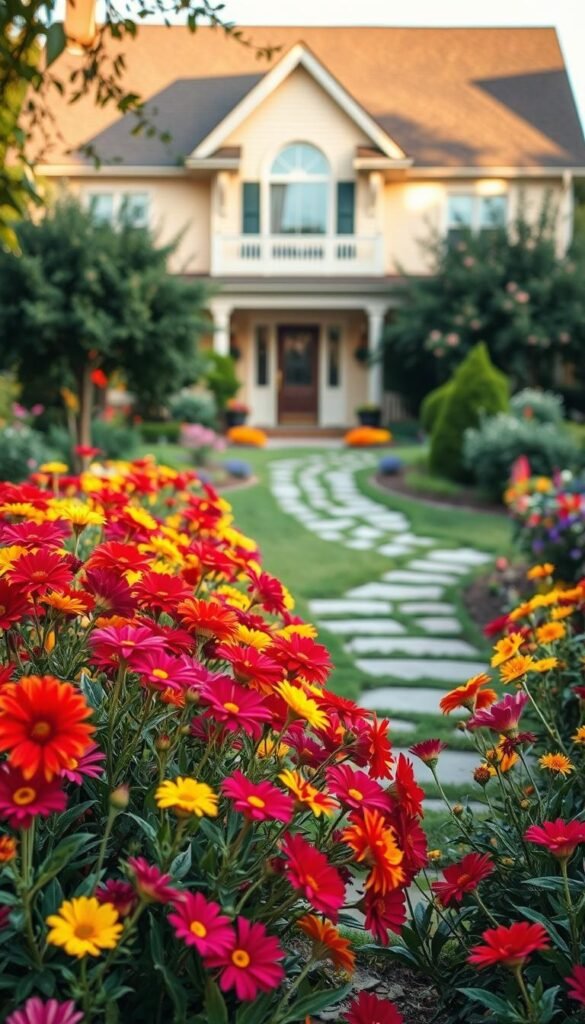Your home’s exterior speaks before you do. Research from Michigan State University reveals that thoughtful landscaping can elevate perceived property value by up to 11%. This isn’t just about aesthetics—it’s about crafting an environment that welcomes visitors and reflects your personal style.
Strategic plant placement does more than beautify spaces. Studies show vibrant arrangements trigger positive emotional responses, making your residence stand out in the neighborhood. When planning your layout, consider how color combinations complement your architecture—like pairing warm-toned blooms with neutral siding.
Many homeowners overlook their yard’s potential as a design extension. Think of it as an outdoor room where textures and shapes guide the eye. Larger plant groupings create visual anchors, while varied heights add depth and interest.
The right design choices deliver immediate results and long-term benefits. As 92% of real estate professionals note, enhanced outdoor spaces often lead to faster sales. Whether you’re refreshing your look or preparing to sell, every planting decision becomes an investment in your property’s future.
Start with a Solid Plan for Your Front Yard Transformation
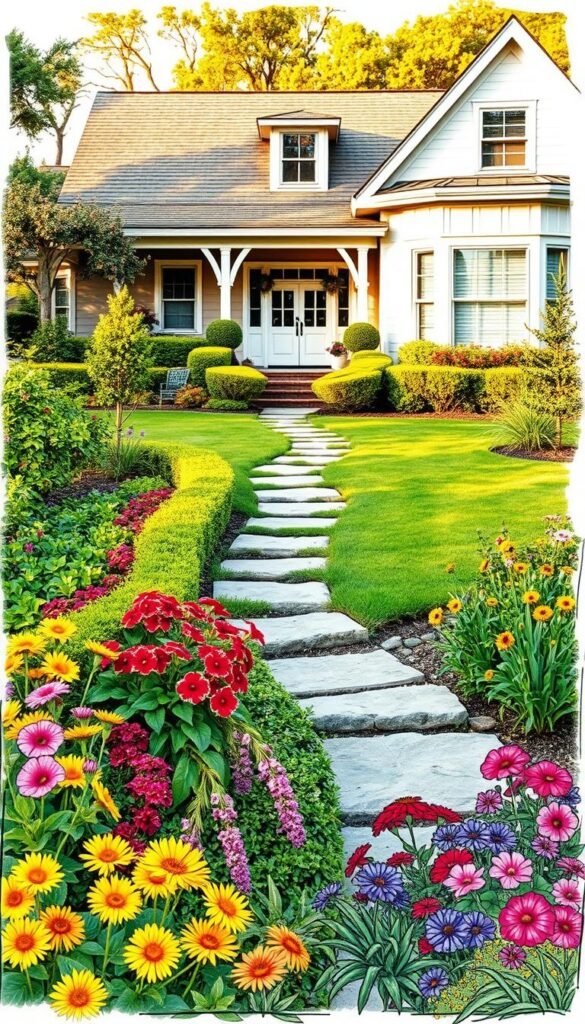
Transforming your front yard begins with smart groundwork. Before digging your first hole, grab a tape measure and notebook. Track sunlight patterns at different times—morning shadows might surprise you. Note where water pools after rain, as these spots need drainage solutions before planting.
Assess Your Space and Home Style
Your home’s architecture sets the design tone. A modern ranch calls for clean lines and drought-resistant plants, while a colonial benefits from symmetrical flower beds. Pro tip: Snap photos of your facade and sketch over them to visualize plant placements.
Define Priorities and Layout
Budget and time shape your project’s scope. Focus on high-impact areas first—like framing walkways with colorful perennials. Create a scaled map marking existing trees and paths. As landscape designer Julie Moir Messervy advises, “Always work with nature, not against it.”
Consider your local climate when selecting plants. Check USDA hardiness zones, but also notice microclimates—south-facing walls create warmer pockets. Group plants with similar water needs to simplify care and conserve resources.
Flower Garden Ideas in Front of the House: Boost Curb Appeal Instantly
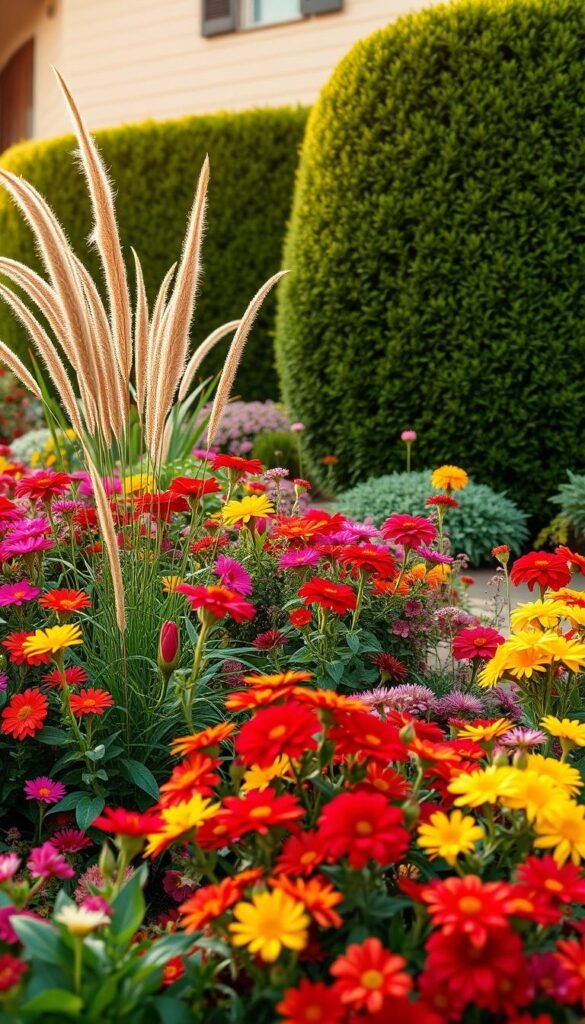
A well-designed entrance landscape acts like a welcoming handshake. Combine plants with contrasting shapes and hues to craft a dynamic display. Start with structural evergreens like boxwoods or junipers—they anchor your design while providing winter interest.
Create Visual Harmony Through Layering
Build depth by arranging plants in three tiers. Place tall varieties like panicle hydrangeas at the back, mid-height coneflowers in the middle, and creeping phlox along edges. This approach guides the eye naturally from ground level upward.
Coordinate your palette with your home’s exterior. Warm-toned marigolds or black-eyed Susans pop against gray siding, while cool lavender and salvia complement brick facades. For year-round appeal, mix container-friendly annuals with perennial bloomers.
| Season | Color Focus | Plant Suggestions |
|---|---|---|
| Spring | Pastels | Tulips, Bleeding Heart |
| Summer | Vibrants | Coneflower, Daylily |
| Fall | Warm Tones | Sedum, Russian Sage |
| Winter | Evergreens | Holly, Ornamental Grass |
Balance bold elements with subtle textures. Feathery maiden grass softens rigid shrub lines, while spiky yucca adds drama to rounded hostas. Remember: odd-numbered groupings (3-5 plants) often look most natural.
Rotate seasonal stars to maintain fresh appeal. Early bulbs make space for summer zinnias, which then yield to autumn mums. This strategy keeps your landscape photo-ready through changing weather.
Maximize Curb Appeal with Creative Walkway and Entrance Designs

Your pathway sets the stage for your home’s story. Materials matter—stamped concrete mimics natural stone at half the cost, while irregular flagstones create rustic charm. Curved designs invite exploration, especially when bordered by whimsical garden styles that blur lines between structure and nature.
Innovative Walkway Materials and Patterns
Break tradition with these eye-catching options:
- Geometric pavers: Create modern grids using contrasting colors
- Pea gravel borders: Add crunch and texture between larger stones
- Glow-in-the-dark aggregates: Illuminate paths naturally after sunset
Straight lines suit minimalist homes, while meandering curves soften angular architecture. Mix materials for visual interest—try brick edging with crushed granite centers.
Highlight Your Front Door with Bold Accents
Frame your entryway like a masterpiece. Symmetrical urns filled with dwarf boxwoods create instant elegance. For contemporary flair, use matching vertical planters with ornamental grasses.
Paint your front door in daring hues that contrast with exterior walls. Deep emerald makes red brick pop, while cobalt blue energizes white facades. Pro tip: Extend your color scheme to outdoor cushions or mailbox details.
Install sconces that cast warm light upward to emphasize architectural elements. Solar-powered stake lights along walkways keep the magic alive all night.
Incorporate Drought-Tolerant and Low-Maintenance Options
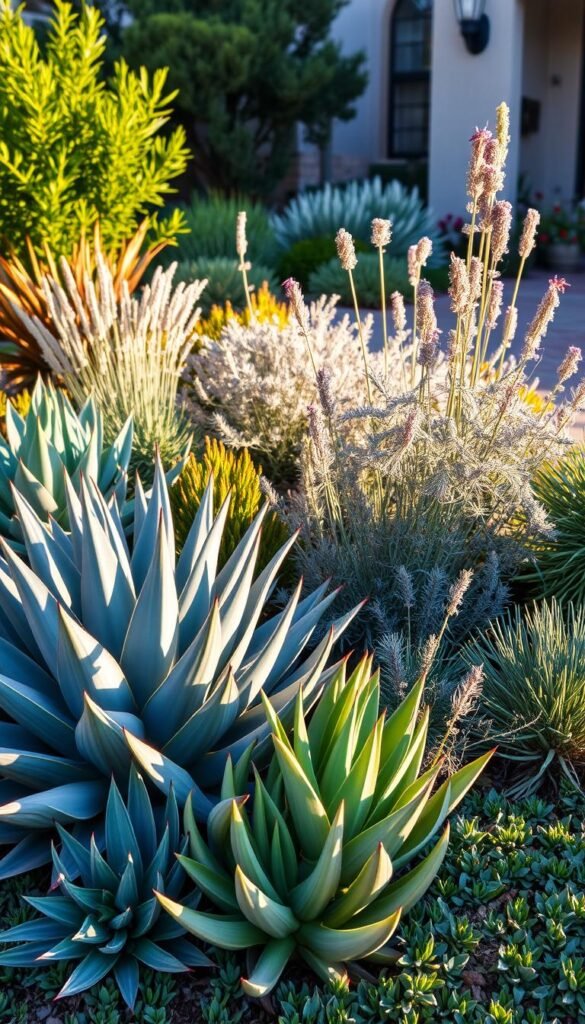
Smart landscaping meets practicality when you embrace drought-resistant solutions. These eco-friendly choices slash water bills while keeping your yard vibrant through dry spells. Start by replacing thirsty grass with gravel paths or decorative pebbles—they add texture and cut maintenance time by up to 60%.
Choose Water-Smart Plant Selections
Build your plant palette around these resilient stars:
- Lavender: Fragrant purple spikes thrive in full sun
- Agave: Architectural shapes with zero fuss
- California poppies: Cheerful blooms that self-seed
Group plants by water needs using the “hydro-zone” method. Native species like blanket flower or penstemon adapt naturally to local rainfall patterns. Pro tip: Add stone mulch around succulents to retain moisture and prevent weeds.
Transform lawn areas gradually—replace one section each season with container arrangements of sedums or hens-and-chicks. Install drip irrigation lines during planting to deliver water directly to roots. This system uses 50% less water than sprinklers while keeping leaves dry and healthy.
For year-round impact, mix evergreen yucca with seasonal bloomers like red-hot poker. These combinations create dynamic displays that withstand heat waves and water restrictions with style.
Blend Traditional Elements with Modern Minimalism
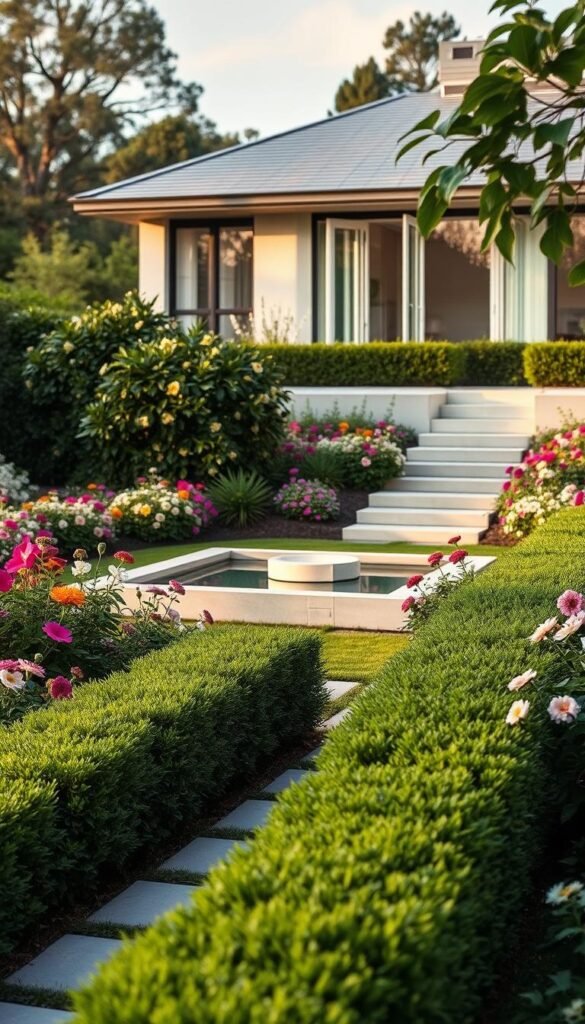
Your landscape tells a story through design choices that balance heritage charm with current trends. Structured lawns act as living frames for your home, while modern accents add fresh character. This fusion creates spaces that feel both familiar and innovative.
Integrate Manicured Lawns and Classic Features
Keep grass crisp with weekly mowing at 3 inches—this height prevents weeds and retains moisture. Edge walkways monthly using a half-moon tool for sharp lines that define spaces. Pair these green carpets with:
| Traditional Element | Maintenance Tip | Style Pairing |
|---|---|---|
| Boxwood hedges | Trim spring & fall | Brick homes |
| Hydrangea bushes | Water deeply 2x/week | Cottage styles |
| Picket fences | Repaint every 3 years | Colonial designs |
Brick pathways gain modern flair when set with steel edging. This mix of materials bridges eras beautifully. Remember: classic shrubs need seasonal pruning to keep their shape sharp against your home’s lines.
Add a Contemporary Twist with Minimalist Landscaping
Swap crowded flower beds for strategic specimens. Try vertical gardening aesthetic elements like wall-mounted succulents. They save space while making bold statements.
Use ornamental grasses as natural sculptures—their flowing blades contrast perfectly with geometric concrete planters. Limit color palettes to three tones for cohesive looks. Dark mulch makes green shrubs pop while suppressing weeds.
Lighting transforms spaces after dark. Install recessed path lights that highlight specimen plants without glare. This approach merges function with sleek style, proving less can truly be more.
Enhance Your Front Yard with Vertical and Container Gardening
Unlock hidden potential in your outdoor space by thinking upward and outside traditional beds. Containers let you experiment with color and texture while vertical systems transform blank walls into lush focal points. Both solutions work wonders for small areas or homes wanting quick seasonal updates.
Creative Container Arrangements for Dynamic Displays
Choose vessels that echo your home’s character—oversized ceramic pots suit farmhouse styles, while geometric planters match modern facades. Group three or five containers near entryways using the “thriller, filler, spiller” formula: tall grasses as centerpieces, mounded begonias for fullness, and trailing ivy softening edges.
Rotate plants quarterly for year-round appeal. Spring tulips make way for summer petunias, followed by autumn ornamental kale. For easy landscaping ideas, use wheeled saucers to rearrange displays as your mood changes.
Utilize Vertical Space to Save Ground Area
Install wall-mounted pocket planters with drought-tolerant succulents or aromatic herbs. Train climbing hydrangea on trellises to soften brick surfaces. Hanging baskets filled with ferns add movement to porches without eating into walkway space.
Remember: vertical gardens need smart irrigation. Use self-watering systems or line planters with moisture-retention crystals. Pair sun-loving nasturtiums with shade-tolerant coleus based on your wall’s exposure.
Wrapping Up Your Curb Appeal Transformation
Crafting your home’s first impression begins where the sidewalk ends. Thoughtful landscaping choices become living investments that grow alongside your property’s value. Every perennial bed and stone pathway contributes to a narrative that welcomes guests while showcasing your unique style.
Remember: success starts with smart planning. Match plant selections to your local climate and home’s architecture. Blend drought-tolerant evergreens with seasonal bloomers for year-round interest. This balance reduces water use while maintaining vibrant appeal through weather changes.
Your outdoor space thrives when combining practicality with creativity. Vertical gardens add dimension to compact areas, while native grasses soften modern hardscapes. Don’t shy away from mixing textures – feathery ferns contrast beautifully with structured shrubs near entryways.
As you refine your exterior, focus on elements that spark joy. Rotate container arrangements seasonally or introduce unexpected focal points like ornamental boulders. These personal touches transform routine maintenance into rewarding self-expression. Your refreshed landscape won’t just turn heads – it’ll create lasting connections between your family and the natural world right outside your door.

